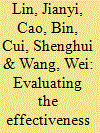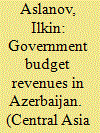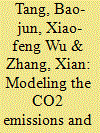|
|
|
Sort Order |
|
|
|
Items / Page
|
|
|
|
|
|
|
| Srl | Item |
| 1 |
ID:
124307


|
|
|
|
|
| Publication |
2013.
|
| Summary/Abstract |
The EU renewable energy (RES) directive sets a target of increasing the share of renewable energy used in the EU to 20% by 2020. The Norwegian goal for the share of renewable energy in 2020 is 67.5%, an increase from 60.1% in 2005. The Norwegian power production is almost solely based on renewable resources and the possibility to change from fossil power plants to renewable power production is almost non-existing. Therefore other measures have to be taken to fulfil the RES directive. Possible ways for Norway to reach its target for 2020 are analysed with a technology-rich, bottom-up energy system model (TIMES-Norway). This new model is developed with a high time resolution among others to be able to analyse intermittent power production. Model results indicate that the RES target can be achieved with a diversity of options including investments in hydropower, wind power, high-voltage power lines for export, various heat pump technologies, energy efficiency measures and increased use of biodiesel in the transportation sector. Hence, it is optimal to invest in a portfolio of technology choices in order to satisfy the RES directive, and not one single technology in one energy sector.
|
|
|
|
|
|
|
|
|
|
|
|
|
|
|
|
| 2 |
ID:
125587


|
|
|
|
|
| Publication |
2013.
|
| Summary/Abstract |
Cities are at the forefront of efforts to combat climate change and in this paper, we examine the influence of urban energy governance on these policy goals. An innovative framework for quantifying the combined governance of cities and energy systems is presented before focusing on a detailed study of London, Paris, Berlin and Copenhagen. By applying an optimization model to assess the lowest cost technology pathways to achieve emission reduction targets, the links between the governance of urban energy systems and the cost of achieving carbon targets are shown. Additionally a novel metric of scenario similarity is introduced in order to evaluate the difficulty of hypothesized energy system transitions. The results indicate that these tools can be valuable in identifying similar cities for the sharing of best practice, for performing comparative evaluations of energy transitions, and for reinforcing the need to complement quantitative assessments with a more holistic appreciation of local context.
|
|
|
|
|
|
|
|
|
|
|
|
|
|
|
|
| 3 |
ID:
150827


|
|
|
|
|
| Summary/Abstract |
Renewable energies are eco-friendly and sustainable. However, their development faces two critical issues: the uncontrollable generation variability, and the high levelized cost. These two issues impede the development of renewables substitution for a government from lacking of clearly argument of how to promote renewables substitution, and what is the role of traditional generation resources should play to back up the renewable energies in a target year. This study aims to depict the possibility of the concerned topic from the aspects of economy, security, and environment, taking a top–down viewpoint of policy-making to address an energy supply problem, and proposes an Energy Supply-Mix Model by considering the complimentary and substitution possibilities between renewable and non-renewable energies, and also among the renewable energies. The solution provides an overall assessment of three aspects under the conditions of supply and demand balance, desired generation percentage of renewable energies, and also ensure no shortage in peak-hour demand. Parametric analysis on the carbon tax is particularly conducted for policy making reference.
|
|
|
|
|
|
|
|
|
|
|
|
|
|
|
|
| 4 |
ID:
121391


|
|
|
|
|
| Publication |
2013.
|
| Summary/Abstract |
Trends in increasing urbanization, paired with a lack of ambitious action on larger scales, uniquely position cities to resume leadership roles in climate mitigation. While many cities have adopted ambitious long-term emission reduction goals, few have articulated how to reach them. This paper presents one of the first long-term scenarios of deep greenhouse gas abatement for a major U.S. city. Using a detailed, bottom-up scenario analysis, we investigate how Seattle might achieve its recently stated goal of carbon neutrality by the year 2050. The analysis demonstrates that a series of ambitious strategies could achieve per capita GHG reductions of 34% in 2020, and 91% in 2050 in Seattle's "core" emissions from the buildings, transportation, and waste sectors. We examine the pros and cons of options to get to, or beyond, net zero emissions in these sectors. We also discuss methodological innovations for community-scale emissions accounting frameworks, including a "core" emissions focus that excludes industrial activity and a consumption perspective that expands the emissions footprint and scope of policy solutions. As in Seattle, other communities may find the mitigation strategies and analytical approaches presented here are useful for crafting policies to achieve deep GHG-reduction goals.
|
|
|
|
|
|
|
|
|
|
|
|
|
|
|
|
| 5 |
ID:
149964


|
|
|
|
|
| Summary/Abstract |
The cement industry is the second most energy-intensive sector in Taiwan, which underlines the need to understand its potential for energy efficiency improvement. A bottom-up model-based assessment is utilized to conduct a scenario analysis of energy saving opportunities up to the year 2035. The analysis is supported by detailed expert interviews in all cement plants of Taiwan. The simulation results reveal that by 2035, eighteen energy efficient technologies could result in 25% savings for electricity and 9% savings for fuels under the technical diffusion scenario. This potential totally amounts to about 5000 TJ/year, of which 91% can be implemented cost-effectively assuming a discount rate of 10%. Policy makers should support a fast diffusion of these technologies. Additionally, policy makers can tap further saving potentials. First, by decreasing the clinker share, which is currently regulated to a minimum of 95%. Second, by extending the prohibition to build new cement plants by allowing for replacement of existing capacity with new innovative plants in the coming years. Third, by supporting the use of alternative fuels, which is currently still a niche in Taiwan.
|
|
|
|
|
|
|
|
|
|
|
|
|
|
|
|
| 6 |
ID:
121744


|
|
|
|
|
| Publication |
2013.
|
| Summary/Abstract |
The long-standing severe power shortage in China has provoked much debate on whether China should further promote market-oriented electricity reform. The present paper addresses this issue by analyzing the impacts of deregulation of the electricity generation sector and retailing activities on other sectors, the macroeconomy and electricity users. A counterfactual scenario analysis is used based on a simplified computable general equilibrium framework. We find that deregulation can significantly improve the efficiency of electricity production, increase employment and enhance household welfare. These nontrivial findings can help to resolve many controversies about governmental intervention during China's economic transition. Our findings have two implications relating to policy feasibility and applicability; that is, competition in the electricity retail market should be phased in, and the necessary arrangements for unemployment in incumbent firms should be considered.
|
|
|
|
|
|
|
|
|
|
|
|
|
|
|
|
| 7 |
ID:
176118


|
|
|
|
|
| Summary/Abstract |
The petrochemical industry plays a pivotal role in achieving high value-added products from oil and gas reserves. With attention to oil and gas reserves in Iran, it is clear that the petrochemical industry has not grown up adequately. This study aims to determine effective factors on petrochemical industry development and model the mechanism of capacity expansion budget creation using a system dynamics approach. A quantified system dynamics model has been built based on causal relationships and the mechanism of development budget allocation among categorized products. This structure is used to simulate the model and investigate essential variables related to each product, such as production capacity value, production rate, domestic sale revenue, and export. According to the results of a simulation, in 2025, Iran will have a capacity of approximately 104 million tons of petrochemical products that is not desirable. In this study, a policy of improving budget plan and allocation is introduced as the most effective solution to achieve the petrochemical industry development. By implementing this policy the production capacity and total revenue would respectively be improved by 4% and 13% in 2025 in comparison with the base run.
|
|
|
|
|
|
|
|
|
|
|
|
|
|
|
|
| 8 |
ID:
093076


|
|
|
|
|
| Publication |
2009.
|
| Summary/Abstract |
The competition for energy resources, as well as the closely related climate change problems, imply a number of global security consequences. A methodology to include energy aspects in long-term defence planning, based on broad civilian scenario approaches, is proposed. The study has been carried out by the Swedish Defence Research Agency, as commissioned by the Swedish Armed Forces, resulting in a number of future mission scenarios highlighting e.g. new challanges and tasks, as well as the need for new capabilities and equipment.
|
|
|
|
|
|
|
|
|
|
|
|
|
|
|
|
| 9 |
ID:
098594


|
|
|
|
|
| Publication |
2010.
|
| Summary/Abstract |
To assess the effectiveness of urban energy conservation and GHG mitigation measures, a detailed Long-range Energy Alternatives Planning (LEAP) model is developed and applied to analyze the future trends of energy demand and GHG emissions in Xiamen city. Two scenarios have been designed to describe the future energy strategies in relation to the development of Xiamen city. The 'Business as Usual' scenario assumes that the government will do nothing to influence the long-term trends of urban energy demand. An 'Integrated' scenario, on the other hand, is generated to assess the cumulative impact of a series of available reduction measures: clean energy substitution, industrial energy conservation, combined heat and power generation, energy conservation in building, motor vehicle control, and new and renewable energy development and utilization. The reduction potentials in energy consumption and GHG emissions are estimated for a time span of 2007-2020 under these different scenarios. The calculation results in Xiamen show that the clean energy substitution measure is the most effective in terms of energy saving and GHG emissions mitigation, while the industrial sector has the largest abatement potential.
|
|
|
|
|
|
|
|
|
|
|
|
|
|
|
|
| 10 |
ID:
149757


|
|
|
|
|
| Summary/Abstract |
Although macroeconomic forecasting forms an integral part of the policymaking process, there has been a serious lack of rigorous and systematic research in the evaluation of out-of-sample model-based forecasts of China's real GDP growth and CPI inflation. This paper fills this research gap by providing a replicable forecasting model that beats a host of other competing models when measured by root mean square errors, especially over long-run forecast horizons. The model is shown to be capable of predicting turning points and to be usable for policy analysis under different scenarios. We find that M2 supply, rather than interest rates, is a key variable for forecasting macroeconomic variables. Annual GDP growth for the next five years is predicted to be close to the 6.5% official target and a future GDP growth path is predicted to be of L-shape rather than U-shape.
|
|
|
|
|
|
|
|
|
|
|
|
|
|
|
|
| 11 |
ID:
126833


|
|
|
|
|
| Publication |
2014.
|
| Summary/Abstract |
The chemical sector is the largest industrial energy user, but detailed analysis of its energy use developments lags behind other energy-intensive sectors. A cost-driven forecasting model for basic chemicals production is developed, accounting for regional production costs, demand growth and stock turnover. The model determines the global production capacity placement, implementation of energy-efficient Best Practice Technology (BPT) and global carbon dioxide (CO2) emissions for the period 2010-2030. Subsequently, the effects of energy and climate policies on these parameters are quantified. About 60% of new basic chemical production capacity is projected to be placed in non-OECD regions by 2030 due to low energy prices. While global production increases by 80% between 2010 and 2030, the OECD's production capacity share decreases from 40% to 20% and global emissions increase by 50%. Energy pricing and climate policies are found to reduce 2030 CO2 emissions by 5-15% relative to the baseline developments by increasing BPT implementation. Maximum BPT implementation results in a 25% reduction. Further emission reductions require measures beyond energy-efficient technologies. The model is useful to estimate general trends related to basic chemicals production, but improved data from the chemical sector is required to expand the analysis to additional technologies and chemicals.
|
|
|
|
|
|
|
|
|
|
|
|
|
|
|
|
| 12 |
ID:
127207


|
|
|
|
|
| Publication |
2014.
|
| Summary/Abstract |
the ongoing transformation of the European energy system comes along with new challenges, notably increasing amounts of power generation from intermittent sources like wind and solar. How current objectives for emission reduction can be reached in the future and what the future power system will look like is, however, not fully clear. In particular, power plant investments in the long run and power plant dispatch in the short run are subject to considerable uncertainty. Therefore an approach is presented which allows electricity market development to be assessed in the presence of stochastic power feed-in and endogenous investments in power plants and renewable energies. To illustrate the range of possible future developments, five scenarios for the European electricity system up to 2050 are investigated. Both generation investments and dispatch as well as utilization of transmission lines are optimized for these scenarios and additional sensitivity analyses are carried out.
|
|
|
|
|
|
|
|
|
|
|
|
|
|
|
|
| 13 |
ID:
101406


|
|
|
|
|
| Publication |
2011.
|
| Summary/Abstract |
Development and diffusion of new renewable energy technologies play a central role in mitigating climate change. In this context, small-scale deep geothermal power has seen growing interest in recent years as an environmentally friendly, non-intermittent energy source with large technical potential. Following the first successful demonstration projects, the German geothermal industry is currently experiencing an internationally unparalleled growth. In this study we explore the factors driving this development, and the role geothermal power production could play in the future of the German electricity market. For this, we apply the scenario technique, based on literature analysis and interviews with companies operating actively in the field. Our findings highlight the importance of political support and framework conditions in the electricity market, with the best prospects in a decentralised energy system based on renewable energy sources, where high investment costs and the risk of discovery failure are balanced by the benefits of low-carbon base load power.
|
|
|
|
|
|
|
|
|
|
|
|
|
|
|
|
| 14 |
ID:
143217


|
|
|
|
|
| Summary/Abstract |
This article examines the two main sources of the state budget in Azerbaijan: taxes and oil revenues. In particular, it analyzes variously measured indicators of the tax burden on the Azerbaijan economy compared to other countries in the region and the world, assesses, based on a regression model, the role of the oil factor in generating revenue for the budget, and explores various scenarios for evaluating the sustainability of government budget revenues in the medium term. Based on his assessments, the author shows that steady growth of the non-oil sector by 7%-9% per year is a major condition for maintaining the stability of government revenues in the medium term.
|
|
|
|
|
|
|
|
|
|
|
|
|
|
|
|
| 15 |
ID:
145733


|
|
|
|
|
| Summary/Abstract |
A crucial dimension of bridging the gap between international affairs scholarship and policymaking is the generation of substantive, policy-relevant research programs. We describe the use of scenario analysis as a valuable experiential and problem-based technique for developing innovative research ideas in political science. We focus especially on the scholarly and pedagogical potential of scenarios for doctoral students by describing the structured use of scenarios at the annual New Era Foreign Policy Conference. The features of scenario analysis that commend its use to policymakers also make it well suited to helping political scientists generate policy-relevant research programs. Scenarios are plausible and textured stories that help imagine how the future political-economic world could be different from the past in a manner that highlights policy challenges. Scenario analysis can throw into sharp relief overlooked, yet pressing questions in international affairs that demand focused investigation. In turn, the search for answers can shape important research programs geared toward providing actionable clarity in understanding contemporary global issues and challenges.
|
|
|
|
|
|
|
|
|
|
|
|
|
|
|
|
| 16 |
ID:
110373


|
|
|
|
|
| Publication |
2011.
|
| Summary/Abstract |
To achieve a goal of reducing the emission intensity of carbon dioxide in 2020 by 40-45% relative to 2005 in China, the framework for a low-carbon scenario was developed on a small scale in Minhang District, Shanghai. The STIRPAT model was employed to reveal the factors that contribute to CO2 emissions in this district: the increase of population, affluence and urbanisation level would increase CO2 emissions, but energy intensity would decrease. Stakeholder involvement was another key component of the framework, and in this case, several rounds of negotiation and feedback resulted in fifteen final scenarios with the estimations of CO2 emissions in 2015. For the low-carbon development plan of Minhang District, the model considered the actual capacity and development potential of this district, the best scenario combining with the high rates of affluence growing and energy intensity reducing as well as the middle rates of population growth and urbanisation level. The final CO2 emissions of this scenario were 66.1 Mt in 2015. Based on these results, strategic suggestions have been proposed to reduce future energy intensity in Minhang District through industrial and energy resource structure reformation, lifestyle change and the transportation system improvement in this district.
|
|
|
|
|
|
|
|
|
|
|
|
|
|
|
|
| 17 |
ID:
121336


|
|
|
|
|
| Publication |
2013.
|
| Summary/Abstract |
The Chinese government has outlined plans for developing new energy vehicles (NEVs) to achieve energy conservation and emission reduction. This paper used a logistic-curve to predict the market share of NEVs in the next decade, and then calculated the potential environment benefits of each and every car or the total according to the report of IPCC (2006). The results indicated that NEVs were of benefit in achieving above goals, particularly electric vehicles (EVs). However, they will have a limited impact in the short term. Finally, considering the empirical results and the Chinese reality, this paper proposed corresponding recommendations.
|
|
|
|
|
|
|
|
|
|
|
|
|
|
|
|
| 18 |
ID:
107522


|
|
|
|
|
| Publication |
2011.
|
| Summary/Abstract |
Concentrated solar power (CSP) plants are one of several renewable energy technologies with significant potential to meet a part of future energy demand. An integrated technology assessment shows that CSP plants could play a promising role in Africa and Europe, helping to reach ambitious climate protection goals. Based on the analysis of driving forces and barriers, at first three future envisaged technology scenarios are developed. Depending on the underlying assumptions, an installed capacity of 120 GWel, 405 GWel or even 1,000 GWel could be reached globally in 2050. In the latter case, CSP would then meet 13-15% of global electricity demand. Depending on these scenarios, cost reduction curves for North Africa and Europe are derived. The cost assessment conducted for two virtual sites in Algeria and in Spain shows a long-term reduction of electricity generating costs to figures between 4 and 6 ct/kWhel in 2050. The paper concludes with an ecological analysis based on life cycle assessment. Although the greenhouse gas emissions of current (solar only operated) CSP systems show a good performance (31 g CO2-equivalents/kWhel) compared with advanced fossil-fired systems (130-900 CO2-eq./kWhel), they could further be reduced to 18 g CO2-eq./kWhel in 2050, including transmission from North Africa to Europe.
|
|
|
|
|
|
|
|
|
|
|
|
|
|
|
|
| 19 |
ID:
149906


|
|
|
|
|
| Summary/Abstract |
Coal power holds the king position in China's generation mix and has resulted in ever-increasing ecological and environmental issues; hence, the development of the electric power sector is confronted with a series of new challenges. China has recently adopted a new economic principle of the “new economic normal,” which has a large effect on the projection electricity demand and power generation planning through 2020. This paper measures electricity demand based upon China's social and economic structure. The 2020 roadmap presents China's developing targets for allocating energy resources to meet new demands, and the 2030 roadmap is compiled based upon an ambitious expansion of clean energy sources. Results show that electricity demand is expected to reach 7500 TWh in 2020 and 9730 TWh in 2030. Coal power is expected to reach its peak in 2020 at around 970 GW, and will then enter a plateau, even with a pathway of active electricity substitution in place.
|
|
|
|
|
|
|
|
|
|
|
|
|
|
|
|
| 20 |
ID:
111426


|
|
|
|
|
| Publication |
2012.
|
| Summary/Abstract |
To improve estimation efficiency for future projections, the present study has proposed a hybrid algorithm, Particle Swarm Optimization and Genetic Algorithm optimal Energy Demand Estimating (PSO-GA EDE) model, for China. The coefficients of the three forms of the model (linear, exponential, and quadratic) are optimized by PSO-GA using factors, such as GDP, population, economic structure, urbanization rate, and energy consumption structure, that affect demand. Based on 20-year historical data between 1990 and 2009, the simulation results of the proposed model have greater accuracy and reliability than other single optimization methods. Moreover, it can be used with optimal coefficients for the energy demand projections of China. The departure coefficient method is applied to get the weights of the three forms of the model to obtain a combinational prediction. The energy demand of China is going to be 4.79, 4.04, and 4.48 billion tce in 2015, and 6.91, 5.03, and 6.11 billion tce ("standard" tons coal equivalent) in 2020 under three different scenarios. Further, the projection results are compared with other estimating methods.
|
|
|
|
|
|
|
|
|
|
|
|
|
|
|
|
|
|
|
|
|